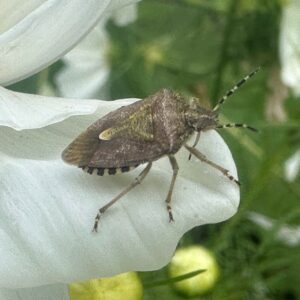Shieldbug
Shieldbugs

When it comes to getting children interested in the natural world, Shieldbugs are one of the go-to creatures. They are found across a wide variety of habitats; gardens, grasslands, woodlands and coastal areas. Their common collective name is due to the triangular medieval, shield-like shape of the adults when seen from above.
Shieldbugs are ‘true bugs’ and not to be confused with beetles. One of the differences between the two is that beetles have powerful biting jaws while bugs suck with a piercing beak-like mouthpart known as a rostrum. This enables them to extract juices from plants and sometimes other invertebrates. Although Shieldbugs mainly feed on plants, some like the Blue Shieldbug are carnivorous and feed on other smaller invertebrates, which are considered pests in crops and in the garden. As well as being a predator other species like spiders, centipedes and small mammals predate on them. This is where the name ‘Stinkbug’ also comes from. When they feel threatened they release an unpleasant smelling fluid from the scent gland on their abdomen.
There are over 60 species of Shieldbugs in the UK, including some non-native species that have become established here. Although they have their scientific name, the common names of different types relate to anything from food plants and location, to colour and appearance, e.g. Juniper, Hawthorn, Hairy and Tortoise Shieldbug. Their food plant name should be taken loosely as they are often found on more than one type of plant.
Lifecyle
These insects go through numerous shedding stages known as ‘instars’ similar to Ladybirds. They do not have a pupa stage. The adult female Shieldbug lays clusters of eggs in late April to early May. The eggs are green/yellow and laid on the underside of leaves and plant stems. These eggs will hatch into nymphs in around May. These nymphs will go through five moults (instars) throughout the Summer, as each exoskeleton is outgrown. In the Autumn, after five sheds, the Shieldbugs become adults. At this stage they have wings and are sexually mature. They will then find somewhere to hibernate in leaf mould, wall crevices, log piles and compost heaps through the Winter until Spring. In April they will re-emerge and mate. Not tidying up your garden in the Autumn will help these insects and others to find a vital place to hibernate.
Harriet English
Find Out More